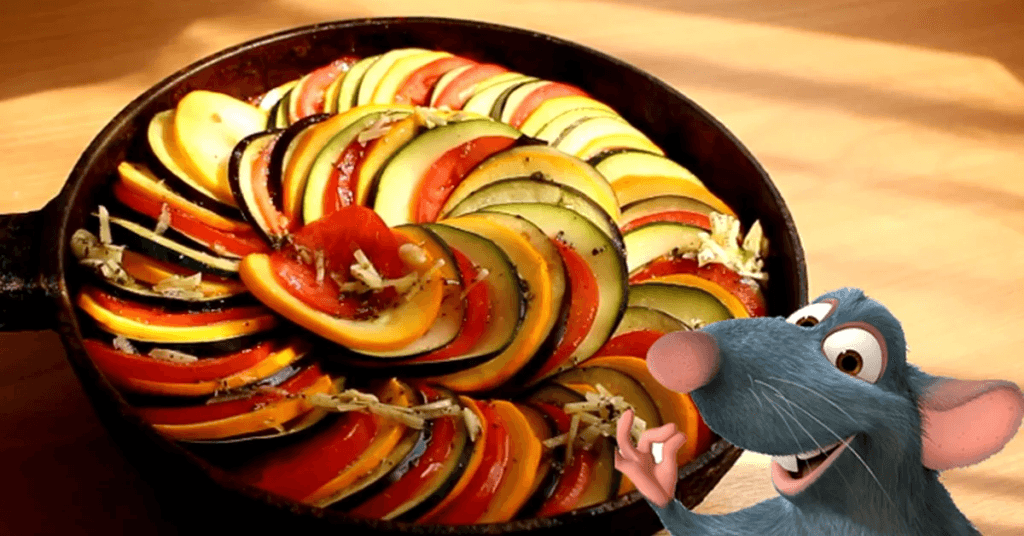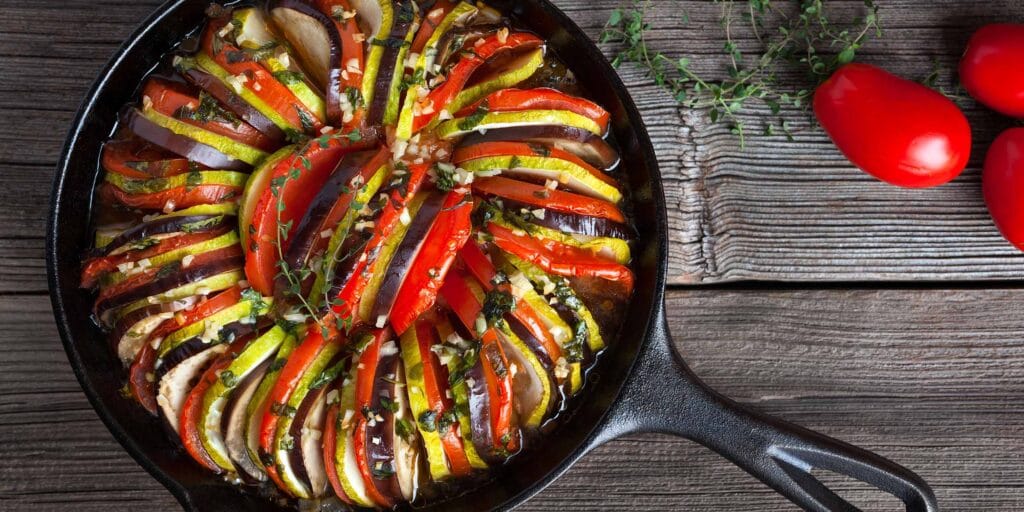Table of Contents
Introduction
Ratatouille is more than just a dish; it’s a celebration of summer’s bounty, a vibrant medley of vegetables that captures the essence of French cuisine. This rustic dish, originating from Provence, is a testament to the beauty of seasonal ingredients and simple cooking techniques. As summer draws to a close, there’s no better time to savor this colorful dish that embodies the flavors of the season.
Ratatouille has deep roots in French culinary tradition, often associated with the peasant cuisine of the Provence region. It showcases the philosophy of using fresh, local produce to create hearty, flavorful meals. The dish has evolved over time, gaining popularity worldwide, especially after the release of the animated film “Ratatouille,” which introduced this classic to a new generation of food lovers. Understanding its cultural significance adds depth to the experience of making and enjoying ratatouille.
Ingredients: The Heart of Ratatouille

- Fresh Vegetables: The key to a perfect ratatouille lies in the quality and freshness of the vegetables. Traditional ingredients include eggplant, zucchini, bell peppers, tomatoes, and onions. Each vegetable contributes its own unique flavor and texture, creating a harmonious blend. When selecting vegetables, opt for organic and locally sourced produce whenever possible to ensure maximum flavor and nutritional value.
- Herbs and Seasonings: Fresh herbs like basil, thyme, and parsley are essential for enhancing the dish’s flavor profile. These herbs not only add aromatic qualities but also complement the natural sweetness of the vegetables. A pinch of salt and freshly cracked black pepper can elevate the dish, while a drizzle of high-quality olive oil adds richness and depth. Consider using herbs de Provence, a blend of dried herbs typical of the region, to infuse the dish with authentic flavors.
- Optional Additions: While the classic ratatouille recipe is simple, feel free to experiment with additional ingredients. Some variations include adding garlic for an extra kick or incorporating olives for a briny contrast. You can also add a splash of balsamic vinegar or a hint of red wine to deepen the flavors. The beauty of ratatouille lies in its versatility, allowing you to tailor it to your taste preferences.
Prepare: The Art of Cooking Ratatouille
- Chopping Techniques: Properly chopping the vegetables is crucial for achieving the right texture and cooking time. Aim for uniform sizes to ensure even cooking. For a rustic presentation, you can cut the vegetables into larger chunks, or for a more refined look, slice them thinly. Consider using a mandoline for perfectly even slices, which can enhance the visual appeal of the dish.
- Cooking Methods: There are various methods to prepare ratatouille, including sautéing, roasting, or layering. The traditional method involves sautéing the vegetables separately to bring out their individual flavors before combining them. This technique allows each vegetable to retain its texture and taste. Alternatively, you can roast the vegetables in the oven for a caramelized flavor or layer them in a baking dish for a visually stunning presentation.
- Layering for Presentation: For a beautiful presentation, consider arranging the vegetables in a spiral pattern in a baking dish. This not only looks impressive but also allows the flavors to meld together as they cook. Drizzle with olive oil and sprinkle with herbs before baking to enhance the dish’s aroma and taste. Baking at a low temperature allows the vegetables to soften while retaining their vibrant colors.
Cooking Time and Temperature
- Optimal Cooking Conditions: Ratatouille is best cooked slowly to allow the flavors to develop fully. A low and slow approach, cooking at around 325°F (160°C) for about 45 minutes to an hour, ensures that the vegetables become tender without losing their shape. This method also allows the natural sugars in the vegetables to caramelize, enhancing the overall flavor.
- Checking for Doneness: The ratatouille is ready when the vegetables are tender and the flavors have melded together. You can test for doneness by piercing the vegetables with a fork; they should be soft but not mushy. If you prefer a slightly firmer texture, you can reduce the cooking time accordingly. Remember that the dish can be enjoyed warm, at room temperature, or even cold, making it a versatile option for any meal.
Serving Suggestions

- Accompaniments: Ratatouille can be served as a main dish or a side. Pair it with crusty French bread to soak up the delicious juices, or serve it alongside grilled meats or fish for a complete meal. It also makes a fantastic filling for omelets or a topping for polenta, showcasing its versatility.
- Garnishing: For an elegant touch, garnish the ratatouille with fresh herbs or a sprinkle of feta cheese before serving. A drizzle of high-quality olive oil or balsamic reduction can also enhance the presentation and flavor. Consider serving it in a rustic dish to highlight its homey, comforting nature.
Easy and Delicious Recipes for Every Home Cook: Your Ultimate Guide
How to Make a Perfect Ratatouille
Conclusion
- Encouragement to Experiment: Ratatouille is a dish that invites creativity and experimentation. Encourage readers to try different vegetable combinations, cooking methods, and seasonings to make the recipe their own. The beauty of ratatouille lies in its adaptability, allowing you to use whatever vegetables are in season or available in your pantry.
- Final Thoughts: As summer comes to an end, take the opportunity to savor the last tastes of the season with this delightful dish. Ratatouille not only nourishes the body but also warms the soul, making it a perfect addition to any meal. Invite readers to share their experiences and variations of ratatouille, fostering a sense of community around this beloved dish.
